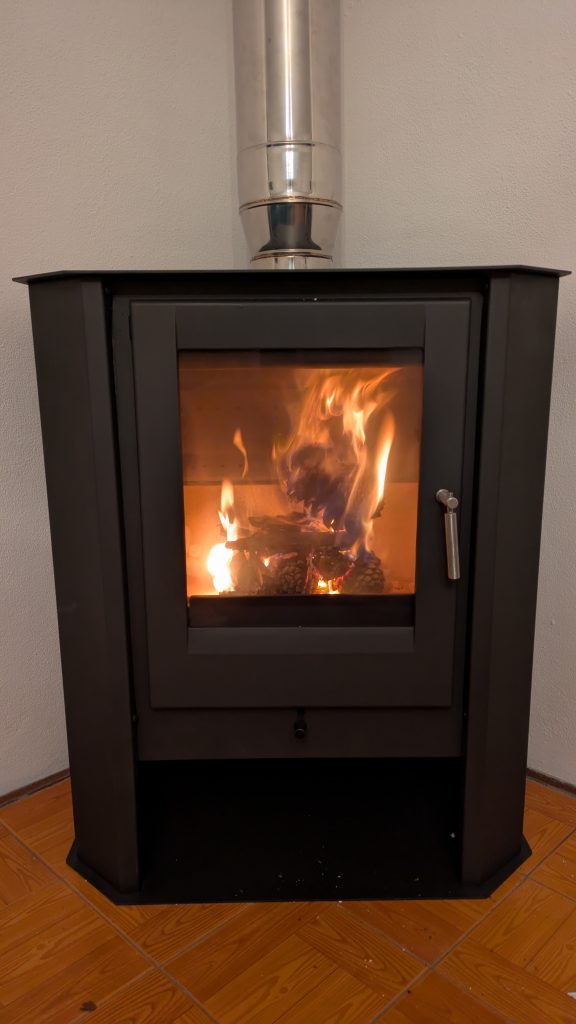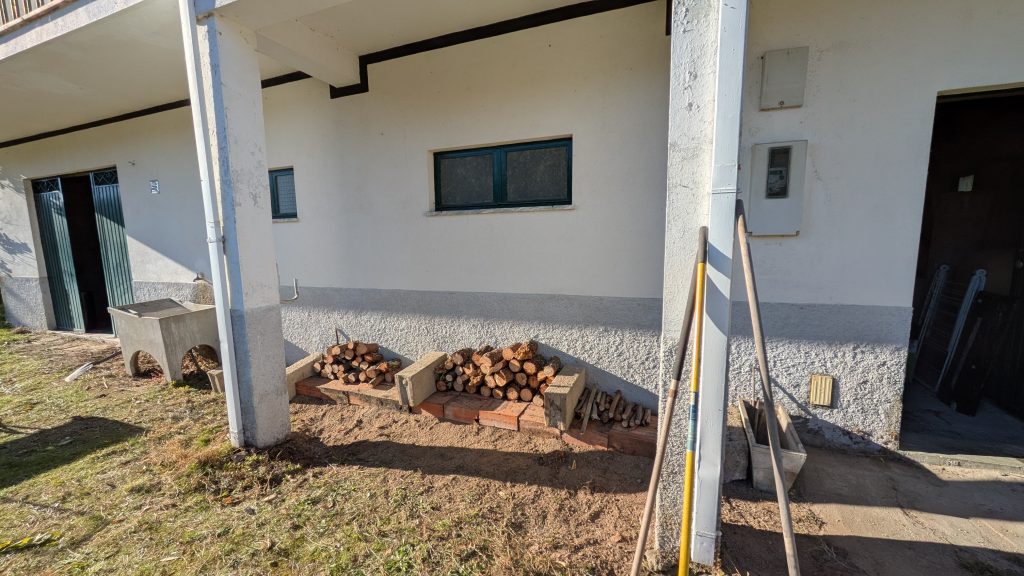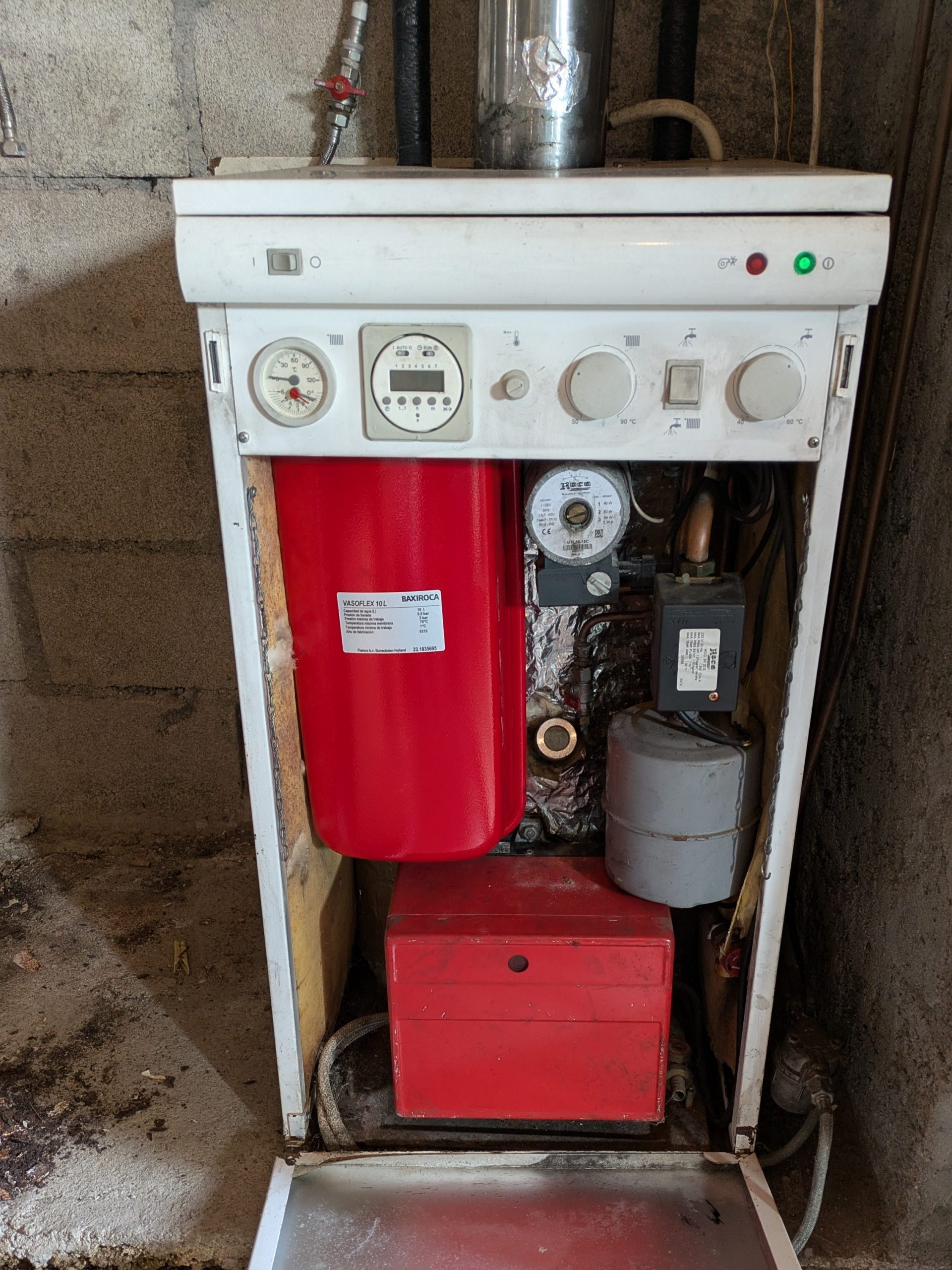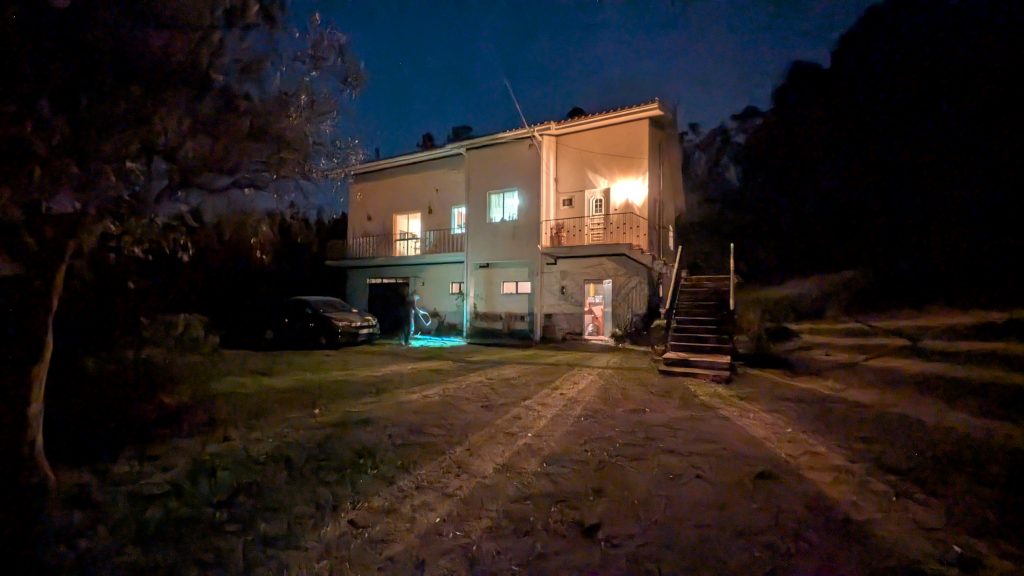First of all, happy new year, feliz ano novo dear readers! Wishing you all a healthy, fun, and resourceful 2025 full of love and whatever you need! As I type this I cannot believe it has been more than 2.5 weeks since we have officially moved in. From that first ice cold night after the longest day in house moving history we have come along way. Not in the least because the heat(ing) is now really on. And that is where we left it in the last blog. Would things heat up? Or would they remain a bit icy?
One of the reasons we liked this house was because it came with one built-in fireplace in the kitchen, a ready-to-go wood burner chimney in the living room, and central heating. The radiators are already there, and even though we knew it was currently running (or supposed to be..) on diesel, the long-term plan was always to switch to a heat pump to warm up those radiators. At least then all the infrastructure was already there, at least the basis, and we could tap into that by just replacing the heat source.
Quick wins: installing the electric boiler and wood burner

The first two things we did on the after moving in was making sure we would have warm water. The boiler was already waiting to be installed in the basement, and, with a bit of luck, it wouldn’t be the most demanding job. The previous owners left all the base-level plumbing and things when they removed the actual boiler, and the only thing we had to do was get the right length flexible pipes, a few new bolts to hang the 100l boiler on in the hopes it wouldn’t fall, connect it all up and switch on the power. Luck was indeed on our side, and everything went as straightforward as that. In under an hour, the boiler was hanging on the wall, and heating up nicely.

The wood burner, the 100kg one that we hauled up the stairs with great effort, was next. The main chimney/outlet in the living room was a bit too short, which meant a trip to BricoMarché to get the connecting bits. We did one exploratory trip and then a final trip to buy them. Cut the big connector to size and hooked it all up. There was no other work or material involved. No special kit or cement to seal the connections whatsoever, which felt a bit weird. But, we wanted to get warm desperately, started with a small fire, got smoked out because the burner was too close to the wall. Moved it forward a bit, and…. Great success! The little burner is great with radiating heat around, so once you get a good fire going, the whole room warms up quickly.
As for fuelling that burner and the fireplace in the kitchen, we have our own forest of around 1 hectare now. Lots of pine cones and twigs to use as fire starters, and larger trees for logs. We spent quite a few mornings scouting our forest for ready-to-be used dried out trees to cut up, to supplement the logs we bought in the store. For now, it will be a combo of our own and store wood while the fresher wood that we’re also cutting up gets to dry first. Next year, however, the aim is to not have to buy any wood at all! We cleared out the front in the first days as well. Removing all sandy old plant pots, and creating a temporary wood storage. We will build a better one where it can air properly, but… all in time!

Getting the central heating up and running

The system we have, a Roca Gavina, also sold under the Baxi brand, is rather old, but still well-used on the Iberian Peninsula. When we moved in, the power switched on, but the actual heater did not fire up as it should. After some asking around and contacting various people, an engineer showed up last week on Monday to fix it (actually, two did in the end because some people just don’t communicate it appears and then just show up without checking if you’re actually there, found someone else, etc., somewhat awkward..), so we were looking to get warm before Christmas! Two parts needed to be replaced, the pump for the diesel and the electrical board. After about 1.5hr of work he got the thing working, and set off again. We were ecstatic and the house was warming up nicely.
This cosy feeling lasted for about 24 hours when on Christmas Eve the heater went dead again and wouldn’t switch back on. Christmas Day was spent mostly working outside, and then in the evening huddling around the wood burner in the living room as it was one of the colder nights. We did message the engineer asking if he’d be able to come back the next day (Boxing Day is not a thing in Portugal), hoping for the best. He did indeed come back (again without confirming, he just… showed up again) and serviced the entire thing, cleaned it, checked it all over again, and then went on his way again. This was now a week ago and it is running rather splendidly.
Diesel central heating – an expensive affair
The only thing that is not so splendid is how quickly it goes through the diesel. After running it rather luxuriously for this week, also because we really wanted to be comfy throughout the holidays, we burnt through so much that after refilling it with a 20l jerry can we are estimating running it like we did would cost around 36 euros per day, those 20 litres at least. What also doesn’t help is that there is little insulation present in the current set-up. Not in the floor, not in the ceiling, and only single-layer glazing throughout the house.
So… we’re going to run it a bit differently now, trying some things out, and getting a bit more comfortable with being colder. Thing is: that is easier when you know you CAN switch it on if you want to, if being a bit colder is a conscious choice.
We had it running while working outside as well, which is a practice that is going, and we had it at around 12 degrees during the night, switching it to around 18/19 between 6.30 and 22.00. That’s now going to become 8.00 and perhaps 19.00 when we are both working, and if we’re out working on the land during the weekends it will be off completely.
Also, we are already more comfortable now than in our rental apartment in Espinho where we had absolutely no heating at all, and as this week the temperatures dropped there to 4 degrees as well overnight, we would have been a gazillion times more miserable. Count your blessings!
Long and short term plans to address these issues
After moving in and thinking about all the things we want to improve, how we want to design the house, etc, we do realise the heat is on to get things underway as soon as possible. In the first 2 weeks, we’ve already made some decisions and semi-decisions:
- Invest in and install a Heat Pump as soon as possible
Even though this was something we had on our wish list/to-do list already, it has certainly moved up in urgency now. It is a bit of an investment, but one that will pay itself back quite easily compared to our current diesel black hole. - Install underfloor heating
Looking at where we would want our furniture to go, how we want to design the kitchen, etc, many radiators were just in the way. They are all in the right places (under a window), so moving them to another location was not really an option. We had mentioned underfloor heating as an option before, but it has now become a decision. Underfloor heating also presents a great opportunity for better floor insulation (currently there is NONE) and who doesn’t want warmer feet in Winter? - Create a false ceiling with extra insulation
This will not only help us with our electrical plans for ceiling lights potentially. It is also a great opportunity to put in extra insulation between the living floor and the attic. At the moment, this is just a brick an concrete layer that will absorb any heat generated in the rooms here. Not very efficient and we can surely do better. We’ll have a look into hemp insulation after seeing Guy and Kylie from Make Do Grow install that in their home among other sustainable options. - Replace the windows as soon as possible
The house currently has single glazed windows. Even though they are surprisingly wind tight, of course they don’t do much to keep the heat inside. So, that’s going on the list for 2025 as well!
It is going to be a very busy year, and even though we’re quite sure we won’t be done with everything on the 1st of January 2026, we do hope to have a lot of things in place before the next winter that will make our life more comfortable in a more sustainable and, in the long term, more affordable way!
Also, if you’re still here… you will probably see another email this weekend announcing something rather exciting, or, so we think. Not another long read, but… something to watch out for for sure… 😉

Gaby en Renee, Eerst ook jullie een heel gelukkig en gezond 2025, en dat jullie nieuwe huis voorspoedig naar jullie wensen en ideen in orde zal komen. Zo te lezen is er nog genoeg te doen. Wij wensen jullie hier sterkte mee. Trouwens, wij vinden het leuk om zo via de mail op de hoogte te worden gehouden en gebracht van jullie voortgang en andere interessanten dingen.
Nou, de groetjes van ons en wees voorzichtig met de werkzaamheden die jullie uitvoeren
ADA & DIK
Dankjulliewel! We vinden het ook fijn dat mensen meelezen en meeleven!
Liefs,
Gaby en René
Glad that you and Rene have been able to feel cosy in the new house. With all the focus on heating, insulation etc I’m intrigued to know what effect (if any) the additions would have to the house being cooler in the summer?
Like Hein said above/below, there is the option to use a heat pump for both cooling and heating, so that is an option we will be exploring for sure, as there is such a wide range in temperatures where we live, from below zero in mid winter to above 40 in Summer!
Any insulation, glazing, etc. will also be helpful with keeping the heat out in Summer (alongside our shutters and double glazing), or, at least, that’s the plan. We don’t have any BIG BIG windows, which the view lover in me thinks is a bit of a shame, but we also know that it is also not very economical/effective with temperature management 😉
What a coincidence: those are the things we did in our new house as well! Perhaps some of our experiences will be helpful:
– If you’re going to use under-floor heating as the only heating source, be mindful of the temperature that’s needed to keep the house warm. Most floor coverings (such as PVC and linoleum) have a maximum temperature of 27C.
– I’m always walking around on socks, it’s just so comfy.
– But it takes a long time to heat up and to cool down. Basically you need to keep it running at all times, because it takes hours to heat up again. Some heat pumps can also cool, that might be nice in the summer.
– We insulated the ceiling with flax fibres! I’m not sure whether that is available in Portugal, but I definitely recommend you check it out. Because it’s a natural fibre, it also regulates the moisture — so you don’t need to mess with vapour tight foils etc. And since it’s not an irritant, you need to take far fewer precautions when working with it. We used https://www.isovlas.nl/isovlas-reno-tg-elegant/ and it’s so comfy.
– Do make sure you have someone making the right calculations (“warmteverliesberekening”) to see how much heat is lost (= how much heat you have to add to keep it warm), what that means for the tubes in the floor (more and wider tubes = more heat dissipation = ability to add more heat to the house), and what that means for the heat pump. In our case, it took the better part of three months before we had a final verdict.
– Our heat pump also heats a 190l tank of hot tap water so we don’t use any gas — we’re full electric.
I’d be happy to answer any questions you have, with of course the caveat that the Netherlands is colder than Portugal.
Thanks so much for sharing and thinking along! We’ve just started putting down the options and the like, and we’re focusing on the initial living area first. We’ll probably at some point look at the attic roof too, but that will then come when we work on making that a bit less bare.
As for your advice/points:
– We will have ceramic tiles of up to 9mm probably, which are if all is well very compatible with underfloor heating
– We will certainly be looking into warming & cooling as it can go up to 40 degrees here in Summer, but also under zero in winter! So there is quite the range we’re going to cover for.
– Putting down flax on the list as potentials! This particular product seems ideal for loft spaces, but might also work on a flat ceiling; it looks great coming with the plasterboards so you can install and then skim over it, I assume.
– Calculations… yes…! We’ll have a notion page dedicated to that, and will see what we can do ourselves here with (educated) guestimates and/or whether we would need someone to help us with that. We want to save a lot of money by ordering the products and doing as much of the installation(s) as we can ourselves, so we’ll have to try and find the balance (and someone who is willing to only do (and be paid for) the advice bit without hiring them to do the work potentially!
– We’re currently gas free as well, and plan to stay that way. So we now have a cheap 100l electric boiler, but will get our hot water from the heat pump as well. The goal is also to connect everything to solar eventually so we only use the net for a back-up to complement our solar batteries if needed!
Don’t expect too much from cooling through the floor ‘heating’ — you can’t go too low or you’ll get condensation in your floor, and you definitely don’t want that! And you also want to avoid a situation that the unit is cooling during the day because it’s above a certain temperature then, and then switches to heating during the night as it cools off.
I expect that we will want a separate airconditioning unit for cooling (and the occassional heating when needed).
We used Heat Box, getting a free two week demo account. You need quite a bit of data, and it might be NL only as it takes geographical information into account as well. But there’s also a Belgian website that does the calculations: https://bouw-energie.be/nl-be/bereken/warmteverliesberekening . You need a lot of data, though.
We went through this process with the information we had, and interestingly enough our calculations were close to the “official” ones…
Happy New Year! It’s snowing here in the UK & 0°C. You’re making great progress Gaby!
Happy new year to you too!
Yesterday we had quite the rainy storm here in Portugal as well, but it wasn’t cold enough/we aren’t high up enough for snow! Think there was some snow at the top of the Serra da Estrela about an hour away from here though!